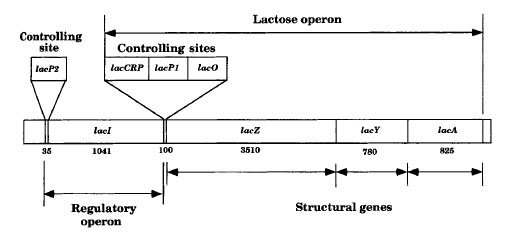Prokaryotic Genes
Structural genes are the nucleotide sequences of DNA that serve as templates for the synthesis of RNAs. The average length of structural genes specifying proteins in prokaryotes is about 1,000 bp, compared to about 10,000 bp in eukaryotes. Structural genes and the controlling sites that regulate the rate of transcription of these genes are called operons (Figure 4-1).Regulatory proteins are proteins that affect the expression of structural genes by binding to controlling sites near the structural genes and either activating or repressing transcription. Regulatory proteins that stimulate gene transcription are termed transcription factors or activators. Repressors are proteins that inhibit the initiation of transcription when bound to controlling sequences called operators. Proteins that terminate transcription are referred to as terminator proteins. However, the end of transcription is most often signaled by a specific terminator sequence found in the DNA or newly transcribed RNA. In general, activators stimulate RNApolymerase binding to promoter sites on DNA at the beginning of structural genes, whereas repressors inhibit RNA polymerase binding. Controlling sites are short nucleotide sequences of DNA , usually 15-30 bp long, that control the expression of structural genes next to them.
The simplest operon consists of one structural gene and one promoter to serve as a binding site for RNA polymerase. These operons are constitutive, that is, they are expressed at all times. The regulatory operon in Figure 4-1 is an example of a simple operon. Some simple operons may be regulated by an attenuator, which codes for RNAstructure that causes the RNA polymerase to prematurely cease transcribing.
 |
| Figure 4-1 Structure of the lactose operon. |
Most operons in bacteria consist of numerous structural genes and controlling sites. In bacteria, many operons contain more than one structural gene, or cistron. These polycistronic operons are transcribed into a single mRNA. Each protein-coding region in the mRNA is defined by its own start codon, where protein synthesis is initiated, and a nonsense codon, where protein synthesis is terminated. Operons in eukaryotes are usually monocistronic, that is, they contain a single gene. A regulon is a group of operons under the control of a regulatory protein. The operons in a regulon are generally not contiguous.
Notes
Controlling sites:
Promoters
Operators
Initiators
Attenuators
Terminators




